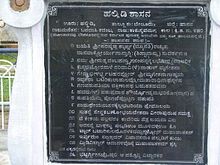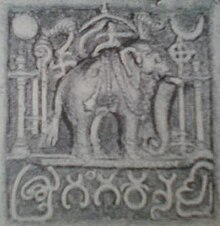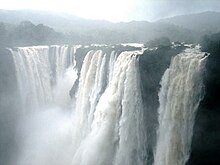Timeline of Karnataka


The name Karnataka is derived from Karunadu, meaning 'lofty land' or 'high plateau', due to its location on the Deccan Plateau. The name can also mean 'land of black soil' (kari, 'black'; nadu, - 'area' or 'region') in Kannada. There are other possible roots of the name.[1] The recorded history of Karnataka goes back to the Ramayana and Mahabharata epics. The capital of "Baali" and "Sugriva" referenced in the Ramayana is said to be Hampi.[citation needed] Karnataka is mentioned in the Mahabharata as "Karnata Desha".[2]" Historically, the region was also called "Kuntala Rajya".[3]
Karnataka was also part of the Dakshinapatha (southern region) which is mentioned in many Indian epics. Vatapi, associated with the sage Agastya, is identified with Badami in Bagalkot district.[4]
Prehistory

During 4th and 3rd century BCE, Karnataka was part of
Starting period
| Time Period / Era | Empire / Dynasty | Main Rulers | Empire Extent |
|---|---|---|---|
| Starting period | Shatavahana | Semukha / Gouthamiputhra | Deccan comprising present Andhra, Karnataka, Maharashtra |
Around 3 BCE the
| Time Period / Era | Empire / Dynasty | Main Rulers | Empire Extent |
|---|---|---|---|
| A.D.325 - A.D.540 | Banavasi Kadamba | Mayura Varma / Kakustha Varma | Central, Northern Karnataka, parts of Southern Maharashtra |

The
Gangas of Talakad
| Time Period / Era | Empire / Dynasty | Main Rulers | Empire Extent |
|---|---|---|---|
| CE.325 - CE.999 | Gangas of Talakad | Avanitha / Durvinitha / Ratchamalla | South Karnataka / parts of Andhra and Tamil Nadu |

The
Chalukyas of Badami
| Time Period / Era | Empire / Dynasty | Main Rulers | Empire Extent |
|---|---|---|---|
| CE.500 - CE.757 | Chalukyas of Badami | Pulakeshin II / Vikramaditya II | Most of Karnataka and Maharashtra, large parts of Andhra Pradesh, parts of Madhya Pradesh, Gujarat, Orissa |

The
Rastrakuta of Manyakheta
| Time Period / Era | Empire / Dynasty | Main Rulers | Empire Extent |
|---|---|---|---|
| CE.757 - CE.973 | Rastrakuta of Manyakheta (modern Malkhed) | Druva Dharavarsha / Krishna I / Govinda III / Nrupatunga Amoghavarsha I / Indra IV / Krishna III | All of Karnataka and Maharashtra, large parts of Andhra Pradesh, Tamil Nadu, Madhyapradash, extended to Kannauj at their peak. |

The name Rastrakuta is a formal title like Patela, Gowda, Hegade, Reddy etc. Dantidurga and his son Krishna overtook the empire from
Chalukyas of Kalyana
| Time Period / Era | Empire / Dynasty | Main Rulers | Empire Extent |
|---|---|---|---|
| CE.973 - CE.1198 | Chalukyas of Kalyana | Vikramadithya VI | Entire Karnataka and Maharashtra, large areas in Andhra Pradesh, parts of Tamil Nadu and Madhya Pradesh while at their peak |

After the Rastrakutha came to the Chalukya who ruled from Kalyana. The most famous among them was Vikramadihya 6th. He was responsible for the setting of a new era called "Vikrama shaka". An important event that took place during this period (c. 1150 CE) is the social and religious movement of
Sevunas of Devagiri
| Time Period / Era | Empire / Dynasty | Main Rulers | Empire Extent |
|---|---|---|---|
| CE.1198 - CE.1312 | Sevunas of Devagiri | Singana II | Northern Karnataka, most of Maharashtra, and parts of Andhra Pradesh |

The Sevunas were from
Hoysalas of Dwarasamudra
| Time Period / Era | Empire / Dynasty | Main Rulers | Empire Extent |
|---|---|---|---|
| CE.1000 - CE.1346 | Hoysalas of Dwarasamudra | Vishnuvardhana / Ballala II | Southern Karnataka including the coast, parts of Andhra Pradesh and Tamil Nadu |

The
The world-famous
Vijayanagara
| Time Period / Era | Empire / Dynasty | Main Rulers | Empire Extent |
|---|---|---|---|
| CE.1336 - CE.1565 | Vijayanagara | Devaraya II / Krishnadevaraya | The whole of South India, encompassing present-day states of Orissa and Maharashtra
|

The
Bahamani
| Time Period / Era | Empire / Dynasty | Main Rulers | Empire Extent |
|---|---|---|---|
| CE.1347 - CE.1527 | Bahumani Sultanate | Muhammadshah I / II | Deccan area comprising northern Karnataka and Andhra |

The Bahumani empire was established due to the conquest of the Muslim rulers in south India. The Muslim raids were so intense that in almost two attacks, four empires of the south were destroyed (
Sultans of Bijapur
| Time Period / Era | Empire / Dynasty | Main Rulers | Empire Extent |
|---|---|---|---|
| CE.1490 - CE.1686 | Sultans of Bijapur | Yusaf Addil Khan / Ibrahim Addil Shah II | Bijapur and adjoining areas |

Around c. 1490 CE the empire broke into five parts, of which
Nayakas of Keladi
| Time Period / Era | Empire / Dynasty | Main Rulers | Empire Extent |
|---|---|---|---|
| CE.1500 - CE.1763 | Nayakas of Keladi | Shivappa Nayaka / Rani Channama | Coastal and Central Karnataka |
The
Wodeyars of Mysore
| Time Period / Era | Empire / Dynasty | Main Rulers | Empire Extent |
|---|---|---|---|
| CE.1399 - CE.1761 | Wodeyars of Mysore | Ranadhira Kantirava / Chikkadevaraja | Southern Karnataka, parts of northern Tamil Nadu |

The Yeduraya and Krishnadeva of Yadava clan who came from Dwaraka to Mysore were approached for help to contain Marappanayaka. They defeated and killed him. His heir was married to Yeduraya and he came to crown in c.1399 CE. Mysore was previously called "MahishaMandala" which means the region of demon Mahisha. The demon was killed by a goddess in this region and hence got the name Mysore. The small kingdom was made into a mighty empire by RajaWodeyar. They shifted their capital from Mysore to Srirangapattana. Chikkadevaraja. Wodeyar is the most famous ruler among them and got the title "Karnataka Chakravarthy" by defeating Nayakas (Ikkeri), Sultans (Madurai) and Shivaji. By 1686 CE the kingdom included almost all of south India. In 1687 CE they bought the city of Bangalore from Mughal by paying three lakh Rupees. By 1761 CE Hyder Ali who was a normal soldier took over their empire.
Sultanate of Srirangapattana
| Time Period / Era | Empire / Dynasty | Main Rulers | Empire Extent |
|---|---|---|---|
| CE.1761 - CE.1799 | Sultanate of Srirangapattana | HyderAli / Tippu Sultan | Most of Karnataka, parts Andhra Pradesh Tamil Nadu and Kerala |

Hyder Ali, who overtook the Mysore from the Wodeyars ruled from Srirangapattana. He soon displaced Nanjaraj, the prime minister, and made the Raja a prisoner in his own palace. Tipu Sultan succeeded Hyder Ali. He fought bloody wars against the
Mysore Wodeyars
| Time Period / Era | Empire / Dynasty | Main Rulers | Empire Extent |
|---|---|---|---|
| CE.1800 - CE.1831 | Mysore Wodeyars | Krishna Raja Wodeyar III | Old Mysore area |

After the defeat of Tipu, according to the treaty in 1800 CE, the British divided the state in which
British takeover
| Time Period / Era | Empire / Dynasty | Main Rulers | Empire Extent |
|---|---|---|---|
| CE.1831 - CE.1881 | British Takeover. | Commissioners of British | Old Mysore and other areas |

In 1831 CE the British overtook the empire and appointed the commissioners, who were given the power to rule on behalf of the British empire. Among them,
Mysore Wodeyars
| Time Period / Era | Empire / Dynasty | Main Rulers | Empire Extent |
|---|---|---|---|
| CE.1881 - CE.1950 | Mysore Wodeyars | Krishna Raja Wodeyar 4/Jayachamaraja Wodeyar | old Mysore area |

After a period of British Commissioners' rule, Mysore was given back to the Wodeyars under Jayachamaraja Wodeyar. During this period the urge to independence gained momentum with the result that many leaders were imprisoned. The struggle finally led to the grant of independence to India by the British. The rule of the Wodeyars continued until the Indian independence and finally they merged Mysore with the Indian union which got incorporated into India as a state.
Karnataka State
| Time Period / Era | Empire / Dynasty | Main Rulers | Empire Extent |
|---|---|---|---|
| CE.1956 | Karnataka State | Government | Whole of Karnataka |
After the

Bengaluru City


In around c.1537 CE an important event occurred that of establishment of
Summary
The table shows the summary [19]
| Time Period / Era | Empire / Dynasty | Main Rulers | Empire Extent |
|---|---|---|---|
| Starting period | Shatavahana | Semukha, Gouthamiputhra | Deccan comprising present Andhra, Karnataka, Maharashtra |
| CE.325 - CE.540 | Banavasi Kadamba | Mayura Sharma, Kakusta Varma | Central, Western, Northwestern Karnataka |
| CE.325 - CE.999 | Gangas of Talakad | Avanitha, Durvinitha, Ratchamalla | South Karnataka, parts of Andhra and Tamil Nadu |
| CE.500 - CE.757 | Chalukyas of Badami | Mangalesha, Pulakeshin II | Parts of Karnataka, Maharashtra, Gujarath, Orrisa, Andhra |
| CE.757 - CE.973 | Rastrakutha of Malakeada | Krishna I, Govinda III, Nrupatunga Amoghavarsha I | Parts of Karnataka, Andra, Tamil Nadu, Madhyapradash, Maharashtra |
| CE.973 - CE.1198 | Chalukyas of Kalyana | Vikramadithya VI | Parts of Karnataka, Andra, Tamil Nadu, Madhyapradash, Maharashtra |
| CE.1198 - CE.1312 | Sevunas of Devagiri | Singana II | Parts of Karnataka, Andra, Maharashtra |
| CE.1000 - CE.1346 | Hoysalas of Dwarasamudra | Vishnuvardhana, Ballala II | Parts of south and coastal Karnataka, Andra, Tamil Nadu |
| CE.1336 - CE.1565 | Vijayanagara | Devaraya II, Krishnadevaraya | Most of Karnataka, Kerala, Tamil Nadu, Andhra |
| CE.1347 - CE.1527 | Bahumani | Muhammad Shah I, Muhammad Shah II | Deccan area |
| CE.1490 - CE.1686 | Sultans of Bijapur | Yusaf Addil Khan, Ibrahim Addil Shah II | Bijapur and adjoining areas |
| CE.1500 - CE.1763 | Nayakas of Kelaedi | Shivappa Nayaka, Rani Channama | Parts of Coastal Karnataka |
| CE.1399 - CE.1761 | Wodeyars of Mysore | RajaWodeyar, Ranadhira Kantirava, Chikadevaraja | Old Mysore region |
| CE.1588 - CE.1779 | Nayakas of Chitradurga | Thimmanna Nayaka, Madakari Nayaka | Parts of Central Karnataka,Andra |
| CE.1761 - CE.1799 | Sultanate of Srirangapatana | HyderAli, Tippu Sultan | Parts of Karnataka, Andhra |
| CE.1800 - CE.1831 | Mysore Wodeyars | Krishna Raja Wodeyar III | Old Mysore area |
| CE.1831 - CE.1881 | British Takeover. | Commissioners of British | Old Mysore and other areas |
| CE.1881 - CE.1950 | Mysore Wodeyars | Krishna Raja Wodeyar IV, Jayachamaraja Wodeyar | old Mysore area |
| CE.1956 | Karnataka State | Government | Whole of Karnataka |
Graphical timeline

See also
- History of Karnataka
- Political history of medieval Karnataka
- Etymology of Karnataka
- Kannada literature
- Charition mime
- History of Karnataka
References
- ^ "Karnataka: a 50-year-old name, centuries of legacy". The Hindu. 1 November 2022. Retrieved 28 November 2022.
- ISSN 0971-751X. Retrieved 28 January 2021.
- ^ "The Kuntala and its extent in Karnataka".
- ^ "Manorama yearbook 2002". Malayalam Manorama.
{{cite web}}: Missing or empty|url=(help) - ^ a b c "Timeline".
- ^ "Isila and Brahmigiri Excavation Sites". Archived from the original on 17 May 2008.
- ^ "Kavirajamarga and Amoghavarsha".
- ^ "Satavahana and Prakrit".
- ^ "Kadamba Reference". 16 October 2009.
- ^ "Sharavanabelogala and Ganga contribution".
- ^ "Pulikeshi and his adventures".
- ^ "Huen-Tsang visit to India".
- ^ "Rastrakutas and their empire".
- ^ "Vikrama Shaka and Vikramadithya".
- ^ "Bettydeva and VishnuVardhana".
- ^ "Hoysaleshwara and furgusen comments".
- ^ "Vijayanagar empire and foreign Visitors".
- ^ "Russian Traveller to India - Nikitin".
- ^ "Timeline of Karnataka".
